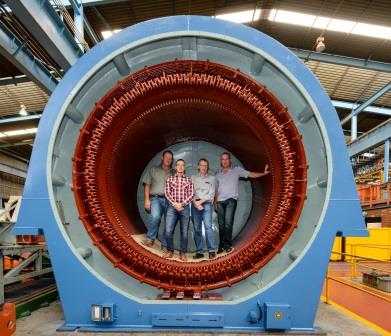Marthinusen & Coutts, a division of Actom, has again demonstrated its impressive ability to undertake challenging work on rotating machinery. The division was recently called upon to assist Goldfields’ South Deep Twin Shafts when the mine experienced a failure on one of the stators on its main winder installation.
Rob Melaia, Engineering and Technical Executive at Marthinusen & Coutts, explains that the sheer physical size of the stator alone is quite unique – especially in terms of the challenges of rewinding such a large unit.
“The 65 t stator mass driving a squirrel cage induction motor very probably makes this the largest motor of its type in the world,” he says. “While there are many larger synchronous motors, it is highly unlikely that there are larger squirrel cage rotor machines.”
He says that the 6 MW, 3.3 Hz, eight pole design of the stator makes it greater than a 90 MW, 50 Hz, 750 rpm equivalent, and that when one adds in the fact that these are driven by cycloconverters, the uniqueness of the installation is apparent.
Following a thorough assessment by Marthinusen & Coutts, it was ascertained that the stator insulation had failed prematurely after approximately eight years, when one would normally expect a 30 year service life from this machine. This failure was unusual in that there was no physical external damage and no signs of overheating. Furthermore with two parallel connected motors one would expect both to fail if a severe external transient was the root cause. The prevailing root cause remained cyclical stresses on the stator insulation due to thermal expansion and contraction cycles.
Melaia says that the identification of the proposed failure mechanism is both new and invaluable in that it identifies a possible weakness with stators, and this, he says, will allow owners to plan and manage any associated risk.
“As a result of the root cause of failure identification, the stator winding and insulation has been redesigned, with the objective of preventing a similar failure,” he says. “The modification made by Marthinusen & Coutts has resulted in a marginal but non-negligible difference to the performance and this, in turn, led to a detailed and very important technical assessment by the cycloconverter drive suppliers.”
There are two identical motors mechanically coupled on the single winder so these have to share the load equally, requiring each of the cycloconverter variable speed drives to load the motors equally. The design change proposed by Marthinusen & Coutts required that they, and the international drive OEM establish whether the load sharing would still be possible with the design modification so as to ensure that this would not impact on the reliable performance of the winders.
“Once this redesign was carried out and verified the way was paved for the design change to be done,” Melaia says.
Testing was done at various set stages during the manufacturing process and included dimensional checks, high voltage checks, dissipation factor tests, impulse inter-turn tests. Despite the 1 470 volt rating of the motor, all coils were tested as if they were well in excess of 3 300 volts nominal rating. This is because the cycloconverter driven stator produces voltage spikes. By overrating the insulation – the reliability and longevity of the winder installation has been improved.
Detailed measurements were taken to ensure absolute accuracy in coil manufacture, and these were manufactured to extremely stringent standards which were dedicated to this particular stator; they exceeded the requisite IEEE and IEC standards.
In total some 8,000 kg of copper was used for the rewind of this stator whose assembled mass is 65 ton. The completed mass of the fully assembled motor is 98 t.
The new stator coils are also arguably the largest set diamond multi-turn coils manufactured in South Africa and on the African continent. Melaia says to add to this challenge resin rich technology was used. “Resin rich technology is a challenge to implement even in small size a coils, so producing successful coils of these proportions is an achievement in itself.”
During the repair process, the mine made use of its spare stator but this was obviously not ideal as it meant should a further failure occur there would not be an additional spare stator.
Marthinusen & Coutts has a long standing association with Goldfields South Deep Twin Shafts and has successfully completed a number of repair and maintenance projects for this mine. Melaia says that an important factor with its entire customer base is that Marthinusen & Coutts’ engineers are always personally involved in, and responsible for, the projects at hand.
“It is this depth of expertise that resides in Marthinusen & Coutts and our ability to undertake such a challenging project on a fast track schedule that underpins our reputation as the leading electrical rotating machinery repairer,” Melaia concludes.









